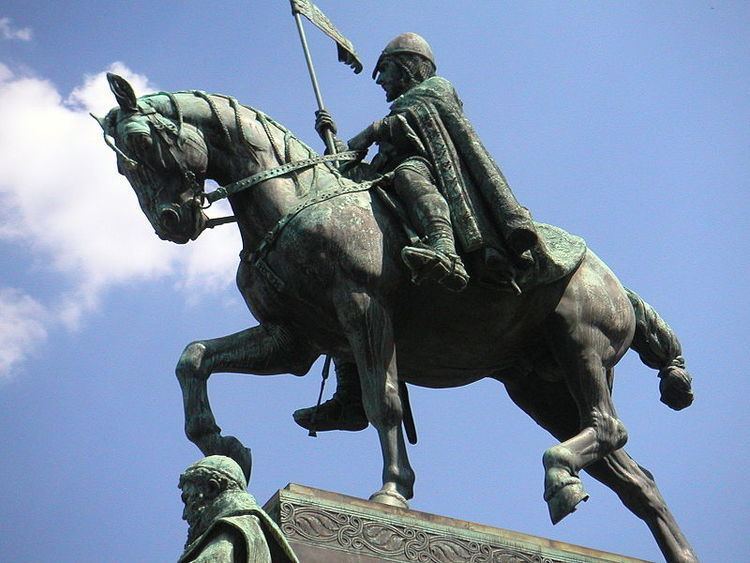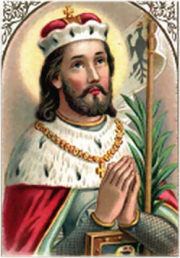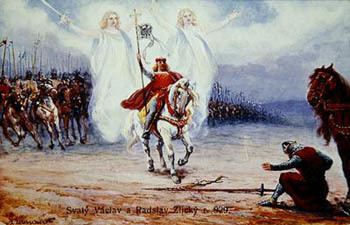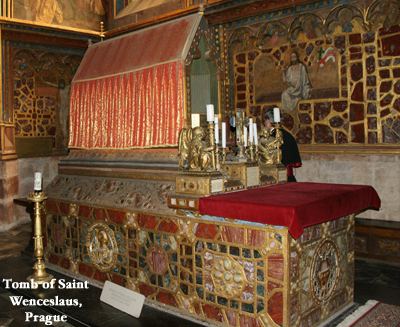Name Wenceslaus Duke | Role King Children Zbraslav | |
 | ||
Attributes Crown, dagger, eagle on a banner Parents Drahomira, Vratislaus I, Duke of Bohemia Siblings Boleslaus I, Duke of Bohemia Grandparents Ludmila of Bohemia, Borivoj I, Duke of Bohemia Similar People Ludmila of Bohemia, Charles IV - Holy Roman E, Boleslaus I - Duke of Bohemia, Borivoj I - Duke of Bohemia, Drahomira | ||
Good king wenceslas
Wenceslaus I (Czech: Václav [ˈvaːtslaf]; c. 907 – September 28, 935), Wenceslas I, Václav the Good or Saint Wenceslaus was the duke (kníže) of Bohemia from 921 until his assassination in 935. His younger brother, Boleslaus the Cruel, was complicit in the murder.
Contents
- Good king wenceslas
- Pianolesdenhaag good king wenceslas
- Biography
- Reign
- Murder
- Veneration
- Wenceslaus in legend
- Legacy
- In popular culture
- References

His martyrdom and the popularity of several biographies gave rise to a reputation for heroic goodness that resulted in his elevation to sainthood. He was posthumously declared to be a king and came to be seen as the patron saint of the Czech state. He is the subject of the well-known "Good King Wenceslas", a carol for Saint Stephen's Day.

Pianolesdenhaag good king wenceslas
Biography

Wenceslaus was the son of Vratislaus I, Duke of Bohemia from the Přemyslid dynasty. His grandfather, Bořivoj I of Bohemia, was converted to Christianity by Saints Cyril and Methodius. His mother, Drahomíra, was the daughter of a pagan tribal chief of the Havelli, but was baptized at the time of her marriage. His paternal grandmother, Ludmila of Bohemia, oversaw his education, and at an early age, Wenceslas was sent to the college at Budweis.

In 921, when Wenceslas was about thirteen, his father died and his grandmother became regent. Jealous of the influence that Ludmila wielded over Wenceslas, Drahomíra arranged to have her killed. Ludmila was at Tetín Castle near Beroun when assassins murdered her on September 15, 921. She is said to have been strangled by them with her veil. She was at first buried in the church of St. Michael at Tetín, but her remains were later removed, probably by Wenceslas, to the church of St. George in Prague, which had been built by his father.
Drahomíra then assumed the role of regent and immediately initiated measures against the Christians. When Wenceslas came of age, he took control of the government. He placed the duchy under the protection of Germany, introduced German priests, and favoured the Latin rite instead of the old Slavic, which had gone into disuse in many places for want of priests. To prevent disputes between him and his younger brother Boleslav, they divided the country between them, assigning to the latter a considerable territory.
Reign
After the fall of Great Moravia, the rulers of the Bohemian duchy had to deal both with continuous raids by the Magyars and the forces of the Saxon duke and East Frankish king Henry the Fowler, who had started several eastern campaigns into the adjacent lands of the Polabian Slavs, homeland of Wenceslas's mother. To withstand Saxon overlordship, Wenceslas's father Vratislaus had forged an alliance with the Bavarian duke Arnulf, a fierce opponent of King Henry at that time. The alliance became worthless, however, when Arnulf and Henry reconciled at Regensburg in 921.
In 924 or 925, at about the age of 18, Wenceslas assumed leadership of the government and had his mother Drahomíra exiled. He then defeated a rebellious duke of Kouřim named Radslav. He also founded a rotunda consecrated to St. Vitus at Prague Castle in Prague, which exists as present-day St. Vitus Cathedral.
Early in 929, the joint forces of Duke Arnulf of Bavaria and King Henry I the Fowler reached Prague in a sudden attack that forced Wenceslas to resume the payment of a tribute first imposed by the East Frankish king Arnulf of Carinthia in 895. Henry had been forced to pay a huge tribute to the Magyars in 926 and needed the Bohemian tribute, which Wenceslas probably refused to pay after the reconciliation between Arnulf and Henry. Another possible reason for the attack was the formation of the anti-Saxon alliance between Bohemia, the Polabian Slavs, and the Magyars.
Murder
In September 935, a group of nobles allied with Wenceslas's younger brother Boleslav plotted to kill him. After Boleslav invited Wenceslas to the feast of Saints Cosmas and Damian in Stará Boleslav, three of Boleslav's companions, Tira, Česta, and Hněvsa, fell on the duke and stabbed him to death. As the duke fell, Boleslav ran him through with a lance.
According to Cosmas of Prague, in his Chronica Boëmorum of the early 12th century, one of Boleslav's sons was born on the day of Wenceslas's death. Because of the ominous circumstance of his birth, the infant was named Strachkvas, which means "a dreadful feast".
There is also a tradition that Saint Wenceslas's loyal servant Podevin avenged his death by killing one of the chief conspirators, but was executed by Boleslav.
Veneration
Wenceslas was considered a martyr and a saint immediately after his death, when a cult of Wenceslas grew up in Bohemia and in England. Within a few decades of Wenceslas' death, four biographies of him were in circulation. These hagiographies had a powerful influence on the High Middle Ages conceptualization of the rex justus, or "righteous king", that is, a monarch whose power stems mainly from his great piety, as well as from his princely vigor.
Referring approvingly to these hagiographies, the chronicler Cosmas of Prague, writing in about the year 1119, states:
But his deeds I think you know better than I could tell you; for, as is read in his Passion, no one doubts that, rising every night from his noble bed, with bare feet and only one chamberlain, he went around to God’s churches and gave alms generously to widows, orphans, those in prison and afflicted by every difficulty, so much so that he was considered, not a prince, but the father of all the wretched.
Several centuries later the legend was claimed as fact by Pope Pius II.
Although Wenceslas was, during his lifetime, only a duke, Holy Roman Emperor Otto I posthumously "conferred on [Wenceslas] the regal dignity and title" and that is why, in the legend and song, he is referred to as a "king".
The hymn "Svatý Václave" (Saint Wenceslas) or "Saint Wenceslas Chorale" is one of the oldest known Czech songs in history. Its roots can be found in the 12th century and it still belongs to the most popular religious songs to this day. In 1918, in the beginning of the Czechoslovak state, the song was discussed as one of the possible choices for the national anthem.
His feast day is celebrated on September 28, while the translation of his relics, which took place in 938, is commemorated on March 4.
Since 2000, the feast day of Saint Wenceslas (September 28) is a public holiday in the Czech Republic, celebrated as the Czech Statehood Day.
Wenceslaus in legend
According to one legend one Count Radislas rose in rebellion and marched against Wenceslas. The latter, sending him a deputation, made offers of peace, but Radislas viewed the king's message as a sign of cowardice. The two armies were drawn up opposite each other in battle array, when Wenceslas, to avoid shedding so much innocent blood, challenged Radislas to single combat. As Radislas advanced toward the duke, he saw, by the side of Wenceslas, two angels who cried to him: "Stand off!" This cry acted like a thunderbolt upon Radislas, and changed his intentions. Throwing himself from his horse, he fell at the Saint's feet, and asked for pardon. Wenceslas raised him and kindly received him again into favor.
A second enduring legend claims a huge army of knights sleep inside Blaník, a mountain in the Czech Republic. The knights will awake and, under the command of St. Wenceslaus, bring aid to the Czech people when they face ultimate danger (see also King in the mountain legends). There is a similar legend in Prague which says that when the Motherland is in danger or in its darkest times and close to ruin, the equestrian statue of King Wenceslaus in Wenceslaus Square will come to life, raise the army sleeping in Blaník, and upon crossing the Charles Bridge his horse will stumble and trip over a stone, revealing the legendary sword of Bruncvík. With this sword, King Wenceslaus will slay all the enemies of the Czechs, bringing peace and prosperity to the land. Ogden Nash wrote a comic epic poem—"The Christmas that Almost Wasn't", loosely based on the same legend—in which a boy awakens Wenceslaus and his knights to save a kingdom from usurpers who have outlawed Christmas.
Legacy
Wenceslaus is the subject of the popular Saint Stephen's Day (celebrated on December 26 in the West) Carol, "Good King Wenceslas". It was published by John Mason Neale in 1853, and may be a translation of a poem by Czech poet Václav Alois Svoboda. The usual American English spelling of Duke Wenceslas' name, Wenceslaus, is occasionally encountered in later textual variants of the carol, although it was not used by Neale in his version. Wenceslas is not to be confused with King Wenceslaus I of Bohemia (Wenceslaus I Premyslid), who lived more than three centuries later.
An equestrian statue of Saint Wenceslaus and other patrons of Bohemia (St. Adalbert, St. Ludmila, St. Prokop and St. Agnes of Bohemia) is located on Wenceslaus Square in Prague. The statue is a popular meeting place in Prague. Demonstrations against the Communist regime were held there.
His helmet and armour are on display inside Prague Castle.
In popular culture
The 1994 television film, Good King Wenceslas, is a highly fictional account of his early life. The film stars Jonathan Brandis in the title role, supported by Leo McKern, Stefanie Powers, and Joan Fontaine as Ludmila.
